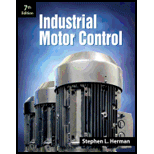
EBK 3N3-EBK: INDUSTRIAL MOTOR CONTROL
7th Edition
ISBN: 9780176919962
Author: Herman
Publisher: VST
expand_more
expand_more
format_list_bulleted
Concept explainers
Question
Chapter 33, Problem 8RQ
To determine
Whether the FCR is the current relay or the voltage relay.
Expert Solution & Answer
Trending nowThis is a popular solution!

Students have asked these similar questions
4- A horizontal Venturi meter is used to measure the flow rate of water through the piping system
of 20 cm I.D, where the diameter of throat in the meter is d₂ = 10 cm. The pressure at inlet is
17.658 N/cm2 gauge and the vacuum pressure of 35 cm Hg at throat. Find the discharge of water.
Take Cd = 0.98.
10
6
Chapter 33 Solutions
EBK 3N3-EBK: INDUSTRIAL MOTOR CONTROL
Ch. 33 - Prob. 1RQCh. 33 - Why is direct current more difficult to interrupt...Ch. 33 - Why are clapper-type contactors generally used to...Ch. 33 - Prob. 4RQCh. 33 - How is the inrush current to large DC motors often...Ch. 33 - Prob. 6RQCh. 33 - How is the FCR connected in relationship to the...Ch. 33 - Prob. 8RQCh. 33 - Prob. 9RQ
Knowledge Booster
Learn more about
Need a deep-dive on the concept behind this application? Look no further. Learn more about this topic, mechanical-engineering and related others by exploring similar questions and additional content below.Similar questions
arrow_back_ios
SEE MORE QUESTIONS
arrow_forward_ios
Recommended textbooks for you
 Understanding Motor ControlsMechanical EngineeringISBN:9781337798686Author:Stephen L. HermanPublisher:Delmar Cengage Learning
Understanding Motor ControlsMechanical EngineeringISBN:9781337798686Author:Stephen L. HermanPublisher:Delmar Cengage Learning Refrigeration and Air Conditioning Technology (Mi...Mechanical EngineeringISBN:9781305578296Author:John Tomczyk, Eugene Silberstein, Bill Whitman, Bill JohnsonPublisher:Cengage Learning
Refrigeration and Air Conditioning Technology (Mi...Mechanical EngineeringISBN:9781305578296Author:John Tomczyk, Eugene Silberstein, Bill Whitman, Bill JohnsonPublisher:Cengage Learning Electrical Transformers and Rotating MachinesMechanical EngineeringISBN:9781305494817Author:Stephen L. HermanPublisher:Cengage Learning
Electrical Transformers and Rotating MachinesMechanical EngineeringISBN:9781305494817Author:Stephen L. HermanPublisher:Cengage Learning

Understanding Motor Controls
Mechanical Engineering
ISBN:9781337798686
Author:Stephen L. Herman
Publisher:Delmar Cengage Learning

Refrigeration and Air Conditioning Technology (Mi...
Mechanical Engineering
ISBN:9781305578296
Author:John Tomczyk, Eugene Silberstein, Bill Whitman, Bill Johnson
Publisher:Cengage Learning

Electrical Transformers and Rotating Machines
Mechanical Engineering
ISBN:9781305494817
Author:Stephen L. Herman
Publisher:Cengage Learning